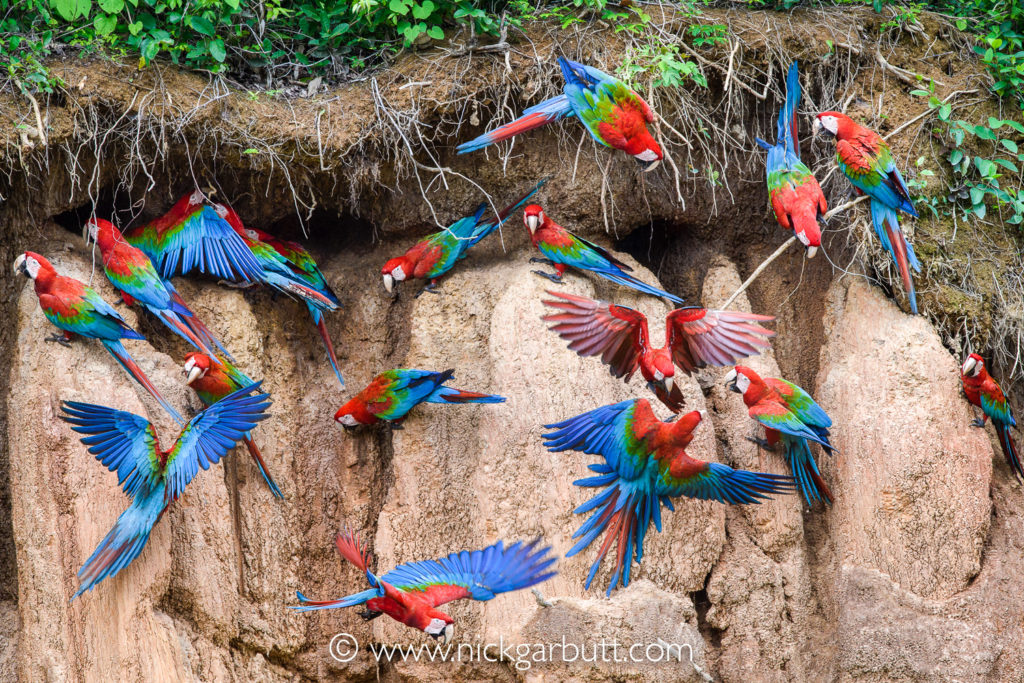Story Behind the Picture: Macaws at Clay Lick
Nikon D5, Nikon 600mm, f8, 1/1000th second
I first became aware of the mind-boggling biodiversity of Manu and Tambopata in the Peruvian Amazon during my undergraduate years at Nottingham University. It sowed a seed. This was further reinforced, when Andre Bartschi won the overall title in the Wildlife Photographer of the Year of 1992 with a sublime image of macaws at a clay-lick. The spectacle became an instant entry on my ‘bucket list’, although it was to take more than a quarter of a century before I was finally able to fulfil it.
When the opportunity to visit Manu and Tambopata eventually came along, the experience did not disappoint. I spent three weeks in the Peruvian Amazon and was able to visit two renowned parrot and macaw clay-licks. The first, Blanquillo in Manu, was terrific, although I was slightly frustrated as the hides (by necessity) were some distance away from the wall of the clay lick where the action took place. I subsequently visited another clay-lick at Heath River, adjacent to Tambopata. Here, the hide was half the distance away and the spectacle more than lived up to expectation.

A riot of colour: red-and-green macaws at the Heath River clay lick
Numerous species of parrot and macaw visit the clay licks virtually every day and I was immediately struck by how structured it was. There was clearly a ‘pecking order’ that was strictly adhered too. Birds began to gather in the nearby trees at first light, but rarely dis they descend to the wall of the clay lick immediately. Not surprisingly they were wary of predators potentially lying in ambush. As the numbers of birds increased there was a building cacophony of discordant squawks and chatter, then eventually one bird broke ranks and fluttered down to the mud wall. The domino effect was instant as others followed en mass.
But the pecking order persisted. Surprisingly, it was the smaller parrot species that took their turn first. During my visits the initial slots were dominated by mealy parrots and blue-headed parrots, while the larger macaw species sat in nearby trees and continued to swell in numbers as more and more individuals arrived. Once the smaller parrots had vacated the clay wall, there was a short hiatus, before the smaller red-bellied macaws descended. There were relatively few of this species and they always chose the same particular area of the clay lick to visit. Finally, one individual red-and-green macaw made a move, and with much squawking flew from its tree down to the vertical mud face. Instantly a riot of colour followed, a tide of scarlet and azure plumage, as dozens of red-and-green macaws followed.
Once on the wall, the macaws calmed and quietened down, concentrating on chewing off chunks of soil. But it was clear they remained on tenterhooks, nervous and ready to fly in an instant should something spook or unnerve them. And if it came, I was hopeful of catching the very moment they exploded away from the wall, envisaging the flurry beating wings and kaleidoscope of intense colour. In the end it didn’t happen in quite the way I had hoped. There was no single instant when the entire flock took to the wing, it was a more measured departure, with individual birds leaving here and there and then finally the last half dozen or so macaws lifting away together.
My photo certainly does not express the innovation of Andre Bartschi’s original, but it remains a vivid reminder and illustration of a spectacle that was worth waiting 25 years to see.
